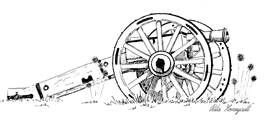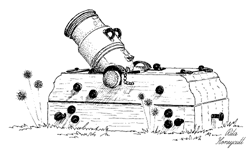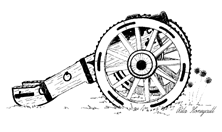ARTILLERY at the SIEGE of YORKTOWN (1781)

Popular images of Revolutionary War battles tend to focus on British and American soldiers engaged in close, hand-to-hand combat. While this may be the case for many of the battles, the Siege of Yorktown was primarily an exchange of artillery fire, waged at long range and relatively few direct troop confrontations. The exact number of artillery pieces used by the British and the Allies during the siege is unknown. Estimates, place the total number of siege and field artillery pieces at upwards of 375. During the eight day siege, the Allies fired an average of 1,700 cannon balls and bombs per day. This comes to about 1.2 every minute.
Yorktown Battlefield in Virginia [managed by the National Park Service (NPS)] has on display 11 artillery pieces which were actually used during the 1781 battle. They are the nine cannons mounted in the wall at Surrender Field Pavilion, plus the 'Lafayette Cannon' and 3 pounder grasshopper cannon on display at the Yorktown Visitor Center. The park also has a number of authentic Revolutionary War pieces which cannot be documented as having been at Yorktown. These original guns are supplemented by 20th century replicas.

There were four types of British, French and American artillery pieces used at Yorktown, all on display at the Park. They include the Field Cannon, the Garrison Cannon, the Howitzer and the Mortar. The field cannon was characterized by a high degree of mobility on the battlefield. The two large wheels attached to a field carriage allowed commanders to position a gun in the field. Gunnery crews fired one of three types of ammunition. The solid ball [shot] was primarily used to destroy forts and cannons, while both grape shot and canister shot were used as anti-personnel weapons. Grape shot and canister shot consisted of small pellets that would scatter when fired against an advancing enemy. The trajectory of the field cannon was flat -- essentally, the cannon is a direct firing weapon.
 The garrison cannon had a flat trajectory also, but in contrast to the field cannon, it tended to be more permanently positioned. It was distinguished by the four small wheels attached to a bulky garrison carriage. The wheels were either cast iron or wooden depending on whether the gun was located in a fort or on a ship. The small cast iron wheels allowed for limited mobility of the piece within a fort.
The garrison cannon had a flat trajectory also, but in contrast to the field cannon, it tended to be more permanently positioned. It was distinguished by the four small wheels attached to a bulky garrison carriage. The wheels were either cast iron or wooden depending on whether the gun was located in a fort or on a ship. The small cast iron wheels allowed for limited mobility of the piece within a fort.
The cannon fired solid ball shot but it also fired a variation of solid ball known as Hot Shot. Hot shot was a regular cannonball heated until it was red hot. Its primary function was to burn ships. During the Battle of Yorktown, the French gunners used hot shot to set afire and sink the British Frigate HMS Charon and two transports. In addition, cannons positioned on shore or on ship fired bar shot and chain shot which was effective at destroying a ship's rigging. Bar shot and chain shot consisted of two cannonballs connected by either a bar or chain.
 The physical characteristics and the firing principle of the mortar differ greatly from both the field cannon and the garrison cannon. The mortar did not have a wheeled carriage. Instead, the barrel was mounted on a wooden, flat bed. An elevating wedge was used to raise the barrel, giving the mortar its characteristic high trajectory shot. Eighteenth century artillerymen used the mortar's high trajectory to launch bombs, which would explode behind enemy lines -- essentally, the mortar is an indirect firing weapon. The bomb consisted of a hollow shell, filled with black powder and equipped with a length of fuse, cut so as to provide a timed explosion. The bomb was rammed down the barrel fuse first. The fuse would be ignited with the cannon's charge.
The physical characteristics and the firing principle of the mortar differ greatly from both the field cannon and the garrison cannon. The mortar did not have a wheeled carriage. Instead, the barrel was mounted on a wooden, flat bed. An elevating wedge was used to raise the barrel, giving the mortar its characteristic high trajectory shot. Eighteenth century artillerymen used the mortar's high trajectory to launch bombs, which would explode behind enemy lines -- essentally, the mortar is an indirect firing weapon. The bomb consisted of a hollow shell, filled with black powder and equipped with a length of fuse, cut so as to provide a timed explosion. The bomb was rammed down the barrel fuse first. The fuse would be ignited with the cannon's charge.
 The howitzer combined the physical nature and firing principles of both the cannon and the mortar in one artillery piece. The howitzer was mounted on a field carriage, giving it a degree of mobility on the battlefield. The howitzer fired hollow shell shot, as well as anti-personnel ammunition. The projectile was fired horizontally or with a high trajectory, depending on the type of ammunition being fired.
The howitzer combined the physical nature and firing principles of both the cannon and the mortar in one artillery piece. The howitzer was mounted on a field carriage, giving it a degree of mobility on the battlefield. The howitzer fired hollow shell shot, as well as anti-personnel ammunition. The projectile was fired horizontally or with a high trajectory, depending on the type of ammunition being fired.
The size of the artillery was designated differently for cannons, mortars and howitzers. The size of all cannons, whether field or garrison, was designated by the weight of the cannonball fired from the particular piece. For example, the 'Lafayette Cannon' was designated a 12-pounder [French expression for this particular weight measurement was 'livres'] because it fired a 12 pound cannonball. The size of cannons during the Revolutionary period ranged from a three pound light field cannon up to 36 pounders. The heaviest guns used at Yorktown were the 18 and 24 pound siege guns. A siege gun was any cannon designated as an 18 pounder or above. The size of the mortar and the howitzer was designated by the width in inches [French expression for this particular span measurement was 'pouces'] across the mouth of the bore. Eight-, ten-, 12- and 13-inch mortars and howitzers were used at Yorktown.
The exact firing ranges of the artillery pieces found at Yorktown are difficult to determine. Factors such as size of gun, amount of powder charge and quality of powder all affected range. The following rough averages can be offered:
| Cannons: | Maximum Range - 2,000 yds (1.2 miles) Effective Range - 1,000 yds (.6 miles) |
| Mortars: | Maximum Range - 1,400 yds (.8 miles) Effective Range - 750 yds (.4 miles) |
| Howitzers: | Maximum Range - 1,300 yds (.8 miles) Effective Range - 750 yds (.4 miles) |
The difference between maximum and effective range and the difficulty in determining ranges underlines the nature of gunnery in the 18th century. Gunnery was not an exact science but rather an art which required that skills, acquired through trial and error. Experience was the key factor in the success of a gun crew. British and Allied gun crews consisted of up to 16 men. Up to ten men were assigned to drag ropes. The ropes were attached to a 'field piece' [mobile gun] and used to maneuver the gun into its battle position. The remaining members of the crew were involved in the firing process. Siege guns, due to their limited mobility, only required a gun crew of eight.
Because of their large size, guns used at Yorktown were only fired once per hour. A more rapid discharge would cause the barrel to droop from the intense heat created from the cannon's explosion. Safety reasons forced gun crews to limit the firing of the siege guns, because sustained firing would have an adverse effect on the inferior metal which comprised most cannons.
Gun crews used a variety of artillery tools in the firing process.






Examples of these tools are on display in the NPS Yorktown Battlefield Visitors' Center.

[Except for images, much of the foregoing text was taken from the an 11 March 2000 NPS webpage, attributted to 'web author' Sandy Groves.]
The French contribution to the Allied artillery effort at Yorktown was considerable both in providing the professional artillerists and in supplying the impressive large artillery pieces. The Americans had some artillery, much of it of British origin, seized at the beginning of the rebellion, and the French had been shipping artllery to the Rebels since 1775. Significantly, Rochambeau brought from France with his expeditionary corps in 1780, a robust siege artillery train. This was conveyed in September 1781 from Rhode Island to Virginia by admiral de Barras' squadron. Some of the French guns were made available to the American artillery under Knox at Yorktown. The historian Lee Kennett [The French Forces in America, 1780-1783, pp.144-145] states that the French artillery commander, colonel Fran�ois d'Aboville, allowed general Knox to 'earmarked' three 24-pounders and twenty 16-pounders. The French siege park contained twelve 24-pounder and eight 16-pounders. These comprised the 'heavy' siege bombardment capabilities of the Allies. In addition, both armies had additional field pieces. Further, de Grasse's had over 2,000 cannon in his fleet, some of which, along with crews, were sent ashore to assist the Allied land armies.
There is a question whether any of the French 'Gribeauval' artillery saw service at Yorktown, 1781. The Gribeauval artillery reforms became famous in the later wars of the French Revolution and Napoleonic campaigns. On this subject, Harold L. Peterson, [Round Shot and Rammers, (South Bend, Indiana,1969, p.54] states:
"..it is a moot point whether any Gribeauval material actually saw service [in America] during the Revolution. The system was adopted in 1767, but immediately there were protests and arguments from artillerists with other ideas. In 1772 these opponents prevailed, and the Valli�re system was returned until 1774, when the Gribeauval system triumphed. None of these new Gribeauval pieces were available for sending to the American colonies during the war, since the changeover was just taking place. It may be that the French artillery that served with [along side and shared some of it ordnance with] the American army at Yorktown had the new materiel. Indeed, most students believe they did, but the point cannot be proved."
One point is very evident in reading the popular accounts of the Yorktown campaign and its related siege operatons, the authors are not very aware of either the degree of French provided material aid -- in terms of the heavy artillery and munitions, and of trained guns crews -- or the necessary French military engineering and artillerist professional skills that made the siege of Yorktown the spectacular victory that it was.